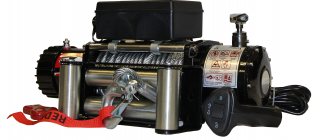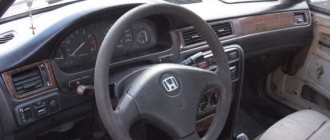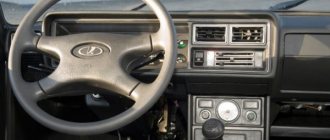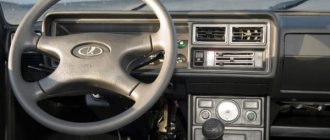Articles
Acoustic shelf VAZ 2115 with subwoofer
For some reason, the following problem may arise: the acoustic shelf of the VAZ 2115 has stopped functioning. Of course, if it is broken, it will not harm the entire car, so repair work can be postponed for a while. However, if you can’t repair it later, you can try to make an acoustic shelf right at home. A home-made acoustic shelf for a VAZ 2115 will look no worse than the standard one.
Why would you need to replace an acoustic shelf?
If the sound quality of the speakers initially satisfied you, then the need to make an acoustic shelf with your own hands may arise for the following reasons:
- damage to the stock part;
- decision to increase the number of speakers;
- to improve sound quality;
- wear of a previously installed element.
Drivers often encounter breakage of shelf fasteners, which occurs while driving on a rough road. Most often, this malfunction is encountered by drivers who do not slow down in front of potholes or on rural rough roads.
However, the vast majority of VAZ-2115 owners replace the acoustic shelf in order to improve the sound quality of music inside the car.
In this case, the shelf should be made of plywood with your own hands or to order. This material will help make the speakers sound clearer.
Solving sound problems
To modernize the acoustic system of VAZ 2114, 2107, 2110 you need to put in very little effort. You can make a shelf for speakers with greater power, diameter, weight, and cleaner sound with your own hands. This is a simple design.
Acoustic shelf for car
Advantages:
- durable, rigid, hard surface, not flexible - if the plastic is replaced with a sheet of plywood or chipboard, the design will be significantly improved;
- static - eliminates the risk of speaker theft.
The difference will be immediately noticeable and will pleasantly surprise you. It takes little time to redo the acoustics - a few hours. The materials will be inexpensive. In addition to the fact that the acoustics should be slightly changed to increase the level of comfort, it is advisable to install soundproofing elements in the cabin.
This will have to be done a little later, as well as the creation of a convertible top for the VAZ 2114, 2107, 2112, and the installation of a stylish steering wheel. Saving money will not be superfluous; it is very good that you can make this important element with your own hands.
Speakers for cars
By the way, a new acoustic shelf for a VAZ 2114, 2115 or another model may also not completely solve the problem of poor sound. The vibration coming from the speakers during their operation will spoil everything, as well as the fragile fixation of the shelf to the base, and displacement when the car moves. Under the shelf you can place a layer of sound insulation, vibroplast.
Any motorist can handle this task - making an acoustic shelf for a VAZ 2107, 2112 or 2115. Making it yourself is no more difficult than restoring an old rocking chair, cutting a dry branch from a tree in the country, or making an indoor fountain from an aquarium pump and a bucket.
Speaker shelf
Preparing to make a shelf
First of all, you will need to prepare the materials and tools that will be required to complete the work. Purchase in advance:
- plywood sheet;
- carpet for cladding;
- radio fabric;
- PVA glue;
- fabric glue;
- a box of self-tapping screws.
The tools that will be useful to you are a jigsaw, a drill or screwdriver, and a grinder.
Please note that the plywood must be at least a centimeter thick, otherwise the shelf will be no more effective than the standard one. Many people are interested in how to take the dimensions of a shelf correctly, so as not to make mistakes during manufacturing. To do this, experienced craftsmen recommend removing the standard shelf and using it for a pattern. In any case, you will have to dismantle it; it is better to do this before cutting the material. This way you definitely won’t go wrong with the size.
Removing the stock shelf is not that difficult. To do this you will need:
- Remove the rear seat.
- Locate the four main acoustic panel fasteners and remove them.
- It is important that the seat belt is fully extended while working. To prevent it from gathering into the tension mechanism, move the two latches and remove the belt guide.
- Unscrew all side frame fasteners.
After dismantling, parts of the old panel can be used as a pattern. In this case, a drawing will not be needed. To do this, first draw them on cardboard, and then transfer them to plywood. You have to prepare the following parts of the structure: main, decorative and adjacent. Next, prepare the side supports and grates.
On the side of the seats, on the main part of the panel, there is no need to make cutouts in the corners, since attaching a homemade shelf can be done differently than a stock one. From the old shelf, cut out the part that fits the rear glass and attach it to the new panel. You can also not take the side walls from the design of the old acoustic panel, but cut them diagonally yourself. By stitching, adjust them to the main part. Assemble the structure with screws. It is enough to screw in only a couple so that in case of a mismatch in size, dismantling can be done easily.
In the main part of the stock panel, two holes are usually pre-made for speakers. If necessary, you can make additional holes, for example, so that the shelf can accommodate several different speakers. In the decorative part, each of the holes should be several millimeters larger. Measure them against the speakers you plan to install. The heads must fit freely into the place prepared for them.
Algorithm of actions
The first task is to dismantle the standard elements, leaving only the metal base.
Attaching the acoustic shelf
After that:
- A drawing is drawn, markings are made on plywood or chipboard. The dimensions of the new surface are practically no different from the dimensions of the standard one. Chipboard sheet is thicker than plywood. If you were able to buy plywood or had it on hand, you can fold it in two or even three layers and glue it with wood glue. A shelf made of one layer of plywood may not be able to withstand the weight of the speakers and will crack. It turns out that the efforts were in vain, a mistake was made.
- The new part is cut out using a jigsaw. Its length may not correspond to the length of the one that was dismantled. You need to check this - try placing it on an iron base in the cabin. The original shelf is usually slightly larger in size due to the specific fixation. The new one should be one centimeter shorter in length. In order not to break the symmetry, shorten the board on both sides by 0.5 mm.
- Cut out holes for the speakers. Markings are applied, taking into account their future location. Don't rush to cut out the parts - if you make a mistake, you'll have to take new sheets of plywood or chipboard and start the whole job all over again.
- Holes for the speakers are cut in the metal base. Markings are made on the metal frame. They are cut using a grinder. This must be done carefully - there is a risk of sparks when the disk and surface interact. It is necessary to use personal protective equipment, such as goggles and gloves, a carpenter's coat or an apron. The car interior should be protected from accidental damage.
- Using an additional layer of plywood or chipboard, you can complicate the configuration of the acoustic shelf and achieve the effect of tilting the speakers in any direction. To do this, you need to draw a drawing of an additional part that will help create an angle. The outline should be transferred to a sheet of plywood or chipboard, cut out this element, glue it with wood glue to the inside of the main sheet, and additionally secure all parts with self-tapping screws.
- The edges are smoothed with a fine-section file and sanded. The resulting product can be coated with a wood primer and varnished so that the material does not deteriorate and lasts a long time. It can be negatively affected by high or low temperature in the car interior and air humidity.
- A cover is sewn from carpet. Carpet performs a thermal insulation function and reduces vibration. It is necessary for the salon to be beautiful and stylish. It will be difficult to guess that in fact the acoustic shelf is not purchased.
- The created structure is installed in the cabin and the speakers are connected.
Speaker shelf
Job completed. The sound system will now function much better. When selling a car, you may feel a little embarrassed when telling a potential buyer about the upgrade. But if a convertible top is made, a new engine or a new steering wheel is installed, the interior, the skirt protects the bumper, the LED system is complicated, a self-made acoustic shelf will not cause surprise or disappointment to the buyer.
How to assemble correctly
The rear acoustic panel is quite easy to assemble:
- Once you have secured the side and main parts, place the speakers in place, secure them and cover them with radio fabric. You can use a grid instead.
- Make a frame from PCB or plywood and cover it with mesh or radio fabric. Glue the material and leave it to dry for several hours.
- Next, glue all the plywood parts and cover the acoustic element with carpet. You can secure the material with glue, but some use a furniture stapler for this purpose.
- A day later, after the shelf has completely dried, you can mount it using the corners. They will be located in the mounting areas of the rear seat of your car. This installation will not take much of your time and effort.
Such a panel will not irritate your ears with squeaks; even speakers that are not of the best quality will sound clearly in it.
Sources
- ladaautos.ru/tuning/kak-samostoyatelno-sdelat-akusticheskuyu-polku-vaz-2115.html
- zen.yandex.ru/media/thesoundteam/akusticheskaia-polka-dlia-vaz-2115-svoimi-rukami-i-kak-ee-izgotovit-5fc5d2b44fa3013b234efc1d
- drive2.ru/l/10564303/
- drive2.ru/l/5940465/
We create acoustic podiums
It doesn’t seem logical to change the shelf, investing effort, time and money into good sounding music, leaving the standard VAZ 2114 podiums, which are made of plastic and eliminates more than half of your work. Plastic does not dampen the vibration of the speakers at all; on the contrary, it enhances it, creating rattling and extraneous noise. Therefore, we will make new podiums, tougher, and making all the previous torment justified.
For the new holder you will need:
- Columns.
- Installation rings (included in the kit).
- Gloves and brush.
- Epoxy glue and hardener.
- Fiberglass and lycra.
If you start creating a podium from scratch, some skills in woodworking and other work with materials will come in handy, firstly, for an untrained person this is unrealistic, and secondly, people with such skills can imagine what exactly needs to be done without this article. Therefore, relying on the option that there are no such skills, as well as special equipment, on the basis of a standard podium we will carry out the procedure for strengthening it using the materials described above.
External acoustic screen
Pros:
- Since a significant part of the screen is located outside the door card, there are many more ideas for implementing different design solutions than in the previous version;
- Inside the screen, some of the sound waves are absorbed, and the desired sound is reflected, making the sound cleaner and the bass deeper;
- The column can be directed in any direction. Car audio enthusiasts often configure their speakers so that most of the sound waves are directed toward the top of the cabin.
Minuses:
- Since the speaker will be attached to the outside of the screen, the case must be as durable as possible;
- It will take time to create the design, as well as money to purchase additional material;
- If you don’t have the skills to install speakers, you can not only ruin the sound, but also break the speaker itself (in addition to the fact that it itself vibrates when the sound is loud, the vibrations intensify while driving, which is why the membrane can quickly tear);
- A certain angle of inclination is required.
What to do?
The operating algorithm is as follows. To begin, turn on the “solo” mode on the track you are working with. Most sound engineers start building their mix around the drums and gradually work their way up through the frequency range (kick, snare, toms, hi-hat, overheads). Every instrument has a specific frequency band in which it sounds and resonates, so if you're miking a kick drum, start at the bottom.
Set up the optimal low end and go on the attack. Very often, after adjusting the sound of a kick drum, some parasitic overtones creep out, such as ringing or hum, even though your low end is excellent and the attack is great. Your next step is to cut out the parasites with a narrow-pass filter. Once you feel comfortable with the sound of the kick drum, mute the track and move on to the next instrument.
Take your time with equalization. The painstaking work will bear fruit, the sound will become more intelligible and clearer. Each instrument will take its place and shine in the mix. Here are some more useful tips:
- Remember that the big picture is more important than individual tools. Your goal isn't to make every track sound as good as possible, but to make the overall sound as compelling as possible. Not every instrument needs a bright attack and a voluminous low end. If you bomb all tracks with the same settings, the instruments will only lose sound. Strive for overall sound perfection
- Take a break from mixing. Your ears get tired just like your whole body. If you work with the same instrument for a long time, your ears gradually become unintelligible and almost insensitive to a particular frequency range. Relax!
- Always compare. Don't rely on your memory. It often happens that you spent 15 minutes on equalizer settings and the sound ended up worse than before processing. Be honest with yourself, give up on bad decisions quickly and without thinking, and start again.
- Don't be afraid to take risks. The best equalizer tricks were invented by those who were not afraid of crazy experiments. Play with the frequencies, because you are the same musician as those whose parts you work with during mixing.
Read more: Adjusting headlights with your own hands: subtleties and nuances
Four bad rooms
We list the main factors of the negative impact of a room on sound:
1. Insufficient, or, conversely, too long reverberation time. This parameter characterizes the “vocality” of the room, that is, the duration of sound attenuation, and is expressed by the time required to attenuate it a thousand times (by 60 dB). A room that is too echoey is just as unsuitable for the normal perception of music as one that is completely deaf, depriving listeners of the slightest sense of spatial volume.
2. Standing sound waves. They arise due to reflections and mutual overlap of low-frequency vibrations, the wavelengths of which are comparable to the size of the room. They are perceived by ear as sharp rises and dips of bass at strictly defined points in space.
Yes, yes, this is how it happens not only with conversations behind you, but also with sound reflections from the acoustics in front of you
3. Early reflections. High-frequency (to a lesser extent - mid-frequency) vibrations reflected from surfaces located near the speakers (mainly bare side walls, floor and ceiling). They enter our ears almost simultaneously with the direct signal, disrupting the correct perception of the localization of sound sources in a stereo panorama. Moreover, the phase mismatch between the direct and reflected waves (which also varies in frequency) leads to a sharp deterioration in the uniformity of the frequency response.
4. Fluttering echo. A series of rapid repetitions of sound at specific frequencies that occurs when speakers are placed between two parallel, highly reflective surfaces.
Manufacturing stages
You should start, like any serious business, with preparation. In this case, you need to remove everything unnecessary from the interior, and then remove the decorative shelf that was installed by the manufacturer and the insulation. We got it like this:
Stage 1. Applying markings. You can use wood, but in our version it is chipboard. The decorative shelf is used as a kind of template.
However, approximately 0.5 cm will need to be removed from each side in order for the shelf to fit into the space allocated for it.
Stage 2. Sawing. Of course, you can do this job manually, but it is better if you have a suitable power tool.
Performing preliminary fitting:
Stage 3. Holes are marked according to the size of the speakers
Now you need to carefully cut the holes, something like this:
Stage 4. Create a template. This way you can install the speakers at the desired angle. In addition, nothing will fall off the shelf. In our version it looked like this:
Now you need to turn it over to get the other half
Next, we lay the finished templates on the chipboard, trace and cut them out.
We glue the resulting second level of the acoustic shelf and further strengthen it with self-tapping screws.
Stage 5. Now you need to try it on again:
The next step is to cut a hole in the iron part of the shelf. Its diameter should be the same or slightly larger than that of the product being manufactured. To do this, you should use a grinder. If access to the trunk is not organized, then you shouldn’t even dream of normal bass sound. You also need to keep in mind that clutter in this cavity does not have the best effect on the sound quality.
Stage 6. We decided that one more level would not be superfluous. This is what it looks like:
And then we installed this:
Stage 7. Cut off all excess, grind and go through with sandpaper
All that remains is to cover the product with a suitable material, in our case it is carpet.
There is no need to use vibroplasts or sound insulation on the acoustic shelf itself, but it is very advisable to cover the trunk with them. Stage 7. It is also the final stage. The almost finished product is installed in place.
In this image you can see that the sound from the speakers will be reflected from the rear window:
It will be useful: The central locking of the Lada Priora does not work: functions and purpose of the system, reasons and diagnostic methods, instructions for repair and restoration of functionality
The VAZ 2107 acoustic shelf with your own hands looks attractive and copes with its functions perfectly. Moreover, no special financial costs were required.
Coaxial or component
Choosing the right speakers is not that easy. There are currently two types of car speakers in use: coaxial and component. Coaxial speakers include several speakers at once, the so-called strips. There are two-, three- and even four-way speakers. Component speakers are designed to reproduce only a certain segment of frequencies: low, high or medium.
Let’s make a reservation right away, the price tag between coaxial and component speakers differs very, very much; component speakers belong to HI-FI and HI-END equipment and are expensive, and also require a professional amplifier (possibly more than one) and competent installation
Moreover, the installation location of such speakers in the car is of no small importance for the overall sound quality
Internal acoustic screen
Pros:
- There is no need to damage the door card, which preserves the interior of the car;
- All elements of the internal screen are hidden under the casing, so there is no need to perform any decorative work for the speakers to not only sound beautiful, but also look decent;
- A powerful speaker will be held more securely, which will allow it to be “swinged” more strongly.
Minuses:
- The speaker will look like a standard speaker. If the emphasis is not only on the beauty of the music, but also on external changes, then it is worth using an external screen;
- The bass won't be as bouncy;
- In such a screen, the loudspeaker will be installed in only one position. Often standard equipment directs the sound wave from the speaker to the feet. This screen option will not allow you to change the tilt angle of the column.
Speaker rotation directly affects tonal balance, soundstage width and imaging
By turning, we mean the speakers turned inward (or outward) towards the listener. This technique is very useful if you want to improve the sound stage and achieve balanced high frequencies. There are no strict rules here - the optimal turning angle depends on the acoustics and the room itself.
The more the speakers are turned towards the listener, the more expressive the highs become. To get the desired sound, you should gradually change the angle of rotation and evaluate the result after each small change.
Among other things, the inward-facing speakers add focus to the sound. As a rule, a large turning angle gives a very pronounced, literally contoured sound stage. Musical images become more independent, collected and clear, and blurriness and spatial uncertainty disappear.
The optimal turn is the position in which the highs are not too dominant, but the concentration in the center of the stage is clearly felt. If the inward turn is made too large, the sound will become too bright. The complete absence of speaker rotation will make the high frequencies smoother, but this will negatively affect imagery. As always, you need to find the best position step by step.
It is also worth noting that the rotation of the acoustics affects the volume of the sound picture. If the speakers are placed upright, the sound stage becomes larger, more expansive, and at the same time less intelligible. The sound will seem “big”, but it will be more difficult to track the position of the instruments. By pointing the speakers at your listening position, the sound can be made much clearer. Finally, the spread of the two columns must be absolutely identical. The level of realism of the sound stage depends on this.
Remember, there is no way around the “listen, adjust, listen” process—it's the only way to find the perfect speaker placement.
Original: The Four Secrets of Speaker Placement
Do you need an amplifier?
We will not go into the features of amplifiers. Let's just consider what it gives and whether it is possible to do without it. An amplifier is primarily needed to increase the output power of the head unit. The inscriptions on the box of the 4x50 W radio tape recorder are true, but only partially; the manufacturer in bright advertising shows the peak power of the device, but in fact there are three powers - nominal, maximum and peak.
Peak power is what the tape recorder is capable of producing at the limit of its capabilities, for a short period of time, with sensitive overheating of the built-in amplifier. We are interested in the rated power - this is something between peak and idle during a song change, the power that the radio delivers most of the time.
The power ratio between the speakers and the amplifier will allow you to choose them correctly for each other. The rated power of the radio is significantly lower than the peak power and an amplifier is required for the full sound of good speakers. But speakers also have their own maximum power, and a powerful amplifier will most likely burn out weak acoustics very quickly. For car acoustics, a 30% power reserve in front of the amplifier is preferable. For example, if the amplifier provides 100 W per channel, then speakers are desirable at 140 W.
It turns out that a good head unit, for example a top-end Pioneer, will handle medium-power speakers without an amplifier, but if you need to make powerful speakers play, you will have to install an amplifier.










